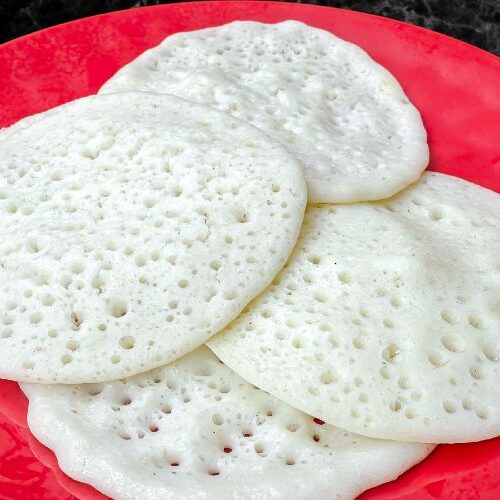
Vellayappam
Start your day with a taste of South India! Vellayappam, also known as Kerala Appam, are soft and lacy rice pancakes that are simply irresistible
Ingredients
- 3 cups raw rice preferably a short-grain variety like idli rice
- 1 cup cooked rice parboiled rice works well
- 1 cup grated coconut
- 1 Tablespoon sugar
- 1 ½ teaspoon salt
- 1 teaspoon Yeast
- Water for grinding
Instructions
Soak the Rice:
- Wash the raw rice thoroughly and soak it in enough water for at least 6-8 hours or overnight. Drain the water.
Prepare the Batter:
- In a blender or food processor, add the soaked raw rice, yeast, cooked rice, grated coconut, sugar, and salt.
- Add enough water to start blending. You may need to add more water gradually to achieve a smooth, thick batter with a pouring consistency. The batter should be neither too thick nor too thin.
Fermentation:
- Cover the batter and leave it in a warm, undisturbed place for about 6-8 hours or overnight. The batter should double in volume and become slightly bubbly.
Prepare the Vellayappam:
- After fermentation, give the batter a good stir to deflate any excess air bubbles.
- Heat a non-stick appam pan or a regular frying pan with a flat bottom. If using a regular frying pan, make sure it has a lid.
- Pour a ladleful of batter into the center of the pan and spread the batter evenly in a circular motion, creating a thin layer.
- Cover the pan with a lid and cook over low to medium heat for 2-3 minutes or until the center is set. You don't need to flip it.
Serve
- Carefully remove the vellayappam from the pan using a spatula and place it on a serving plate.
- Repeat the process with the remaining batter.
Enjoy
- Serve vellayappam hot with your favorite side dishes, such as coconut milk, vegetable stew, egg curry, or chicken curry.
Notes
If it is active dry yeast, dissolve 1 teaspoon of active dry yeast in a little warm water (about 1/4 cup) along with a pinch of sugar. Allow it to froth for about 10 minutes. Mix the yeast mixture into the rice batter and combine well.